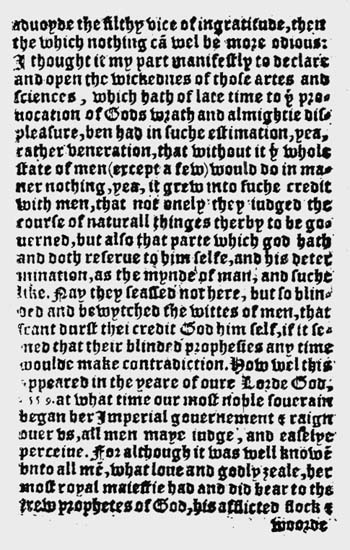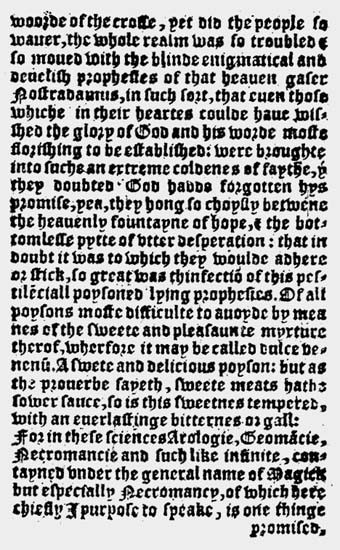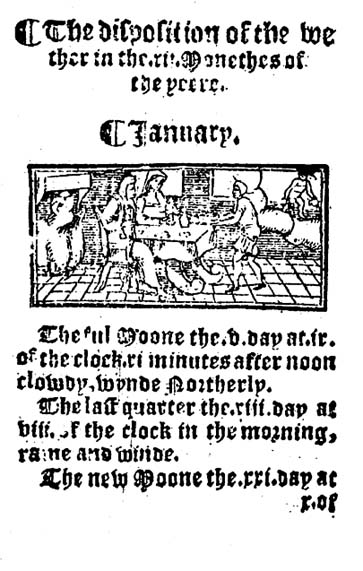CORPUS NOSTRADAMUS 79 -- par Patrice Guinard
La rétractation d'un nécromancien défroqué : Le court traité de Francis Coxe (1561)
Francis Coxe est poursuivi et condamné pour sorcellerie par les autorités ecclésiastiques londoniennes le 25 juin 1561. Il s'ensuit un document intitulé "La sincère rétractation de Francis Coxe" le 7 juillet suivant. Puis le nécromancien est convié à rédiger un pamphlet contre les arts divinatoires : "he was summoned before the privy council on a charge of sorcery, and, having been severely punished, made a public confession of his 'employment of certayne sinistral and divelysh artes' at the Pillory in Cheapside on 25 June 1561. On 7 July following John Awdeley issued a broadside entitled 'The unfained Retractation of Fraunces Cox,' a copy of which is in the library of the Society of Antiquaries. Coxe subsequently published a grovelling and terror-stricken pamphlet entitled 'A Short Treatise' ..." (Dictionary of National Biography, éd. Leslie Stephen, London, George Smith, 1887, vol. 12, pp.418-419).
Le pamphlet, "servile et épouvanté", commence par ce repentir : "I have my selfe ben an offender in these moste detestable sciences, against whome I have compiled this worke, as Astrologie, Necromancie, & suche like." (f.A2v). Ce "recanting pamphlet of a felon under the screw" selon Allen (1941, p.112), serait paru à la fin de l'année 1561 accompagné d'un almanach satisfaisant aux desiderata des autorités : la permission est octroyée à John Alde & John Awdelay d'imprimer un ouvrage de Coxe "agaynste sosserers and Coungerers" with "an Almanacke" (Arber 1, 1875, p.175).
079A A short treatise declaringe the detestable wickednesse of magicall sciences,
as Necromancie, Conjurations of spirites, Curiouse Astrologie and suche lyke
de Francis Coxe
London, John Alde (for John Awdeley ?), [1561], in-8, 16 ff.
° British Library: C.27.a.3
° Cambridge UL: Syn.8.54.52 (6)
° Henry Huntington Library, San Marino (Californie): 59464
° rééd. Amsterdam (Theatrum Orbis Terrarum), New York (Da Capo Press), 1972
- Ames & Herbert, 1819, n.2889, p.571
- Arber 1, 1875, p.175
- Dictionary of National Biography 12, 1887, p.419
- Pollard / Redgrave, 1926 : n.5950
- Allen, 1941, p.112
- Pollard / Redgrave 1, 1986 : n.5950
- Benazra, 1990, p.54
- Brind'amour 1993, pp.440 & 505
Le texte s'inspire de l'Antiprognosticon de Fulke, et lui reprend l'idée d'une influence néfaste des "prophesies" de Nostradamus, et de leurs conséquences déstabilisantes pour le pouvoir royal, suite à la parution, début 1559, de diverses traductions de son Almanach pour l'an 1559. Les prophéties, c'est-à-dire les présages des almanachs, sont qualifiés de faux, énigmatiques, diaboliques, pestilentiels, venimeux, et fallacieux. Mais contrairement à son modèle, Coxe orthographie correctement le nom de l'oracle provençal (cf. CORPUS NOSTRADAMUS 74 et 78).
"Nay, they seassed not here, but so blinded and bewytched the wittes of men, that scant durst thei credit God him self, if it semed that their blinded prophesies any time woulde make contradiction. How wel this appeared in the yeare of oure Lorde God, 1559, at what time our most noble soverain began her Imperial governement & raign over us, all men maye judge, and easelye perceive. For although it was well knowen unto all men, what love and godly zeale, her most royal majestie had and did hear to the trew prophetes of God, his afflicted flock & // woorde of the crosse, yet did the people so waver, the whole realm was so troubled & so moved with the blinde enigmatical and develish prophesies of that heaven gaser Nostradamus, in such sort, that even those whiche in their heartes could have wished the glory of God and his worde most florishing to be established : were broughte into suche an extreme coldenes of faythe, that they doubted God hadde forgotten hys promise, yea, they hong so choysly betwene the heavenly fountayne of hope, & the bottomlesse pytte of utter desperation : that in doubt it was to which they woulde adhere or stick, so great was th[e] infection of this pestilenciall poysoned lying prophesies." (ff.A4v-A5r)


En Angleterre, les prédictions politiques des almanachs, condamnées par les autorités, connaîtront paradoxalement une vogue ininterrompue qui se poursuivra pendant des décennies après leur disparition sur le continent (cf. l'ouvrage de Bernard Capp, 1979). Nostradamus aura été le pionnier incontesté mais mis à l'index de cette littérature britannique : les auteurs d'almanachs de la seconde moitié du XVIe siècle commencent à fabriquer des vers et des quatrains "à la manière de Nostradamus", et William Lilly en 1651 ou encore un William Atwood en 1689 font encore usage de ses Prophéties.
Après sa condamnation, Coxe sera autorisé à publier des almanachs et pronostications strictement techniques (dates des éclipses et des phases lunaires, données saisonnières, vagues conseils médicaux, etc). Il en publiera semble-t-il chaque année. Relevons l'Almanack for 1562 déjà signalé, et les Almanack and prognostication for the yeere 1563, 1565, 1566 et 1567, tous imprimés par le londonien John Alde (cf. Arber 1, 1875, pp.175, 201, 264, 301 et 333 ; Bosanquet, 1917, nn. F43, F49, F66, 65 p.108, F88 ; STC (Pollard & Redgrave), 1926, n.5949 et 1986 (2nd ed.), n.431.7 ; Capp, 1979, p.356).
Il ne subsiste de ces opuscules qu'un fragment de la pronostication pour l'an 1567 (au British Museum) et la pronostication pour 1566 : A prognostication made for the yeere of our Lorde God 1566. Declaryng the chaunge, Full, & Quarters of the Moone, with other, accustomable matters, serving all England (London, John Alde, [1565], in-16, c. 16 ff. (pour l'almanach) + 16 ff., 53 x 77 mm), un texte commençant au folio C2r et détaché de l'almanach qui le précédait (exemplaire à la bibliothèque universitaire de Cambridge : Syn.8.56.7).
<

Quelques indications météorologiques en latin précèdent la description des phases lunaires mensuelles et les illustrations, par une scène triviale, d'une activité quotidienne propre à chaque mois. L'image autorisée se subsitue au texte prétendument subversif, et voilà l'ex-nécromancien dont on ignore tout des premières activités, transformé en exécuteur soumis et rampant des volontés idéologiques, un peu à la manière dont sont aujourd'hui encouragés par le commerce et analysés par les institutions, les horoscopes insipides et même les prédictions pseudo-astrologiques presque toujours démenties par l'actualité, mais inquiétés les authentiques chercheurs en ces domaines.
Retour à l'index
Bibliographie
Retour Nostradamica
Accueil CURA
Patrice Guinard: La rétractation d'un nécromancien défroqué :
Le court traité de Francis Coxe (1561)
http://cura.free.fr/dico6advpl/711Acox.html
4-11-2007 ; updated 20-04-2018
© 2007-2018 Patrice Guinard